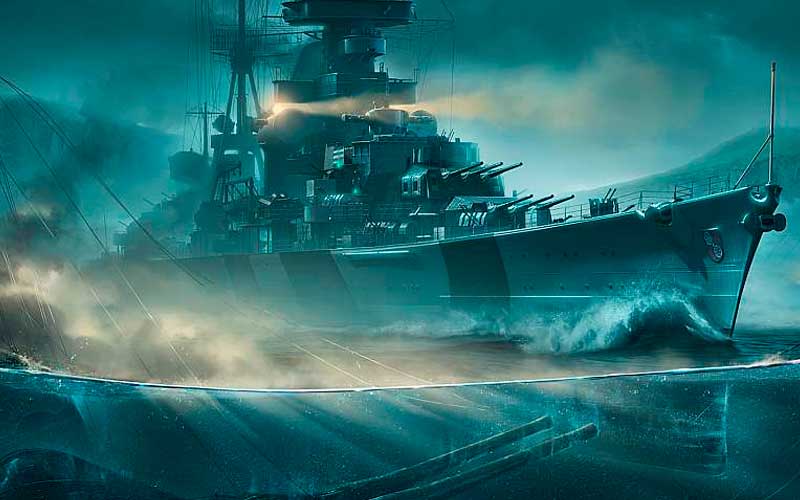Understanding Ship Angling and Armor Mechanics in World of Warships

Understanding Ship Angling and Armor Mechanics in World of Warships
Mastering ship angling and armor mechanics is essential for maximizing your survivability and effectiveness in World of Warships. Properly positioning your ship to minimize damage while maximizing your ability to absorb hits can make the difference between victory and defeat. In this guide, we’ll break down the fundamentals of ship angling, armor layouts, and how to use them to your advantage on the battlefield.
What is Ship Angling?
Ship angling refers to the practice of positioning your vessel at an angle relative to incoming enemy fire. The goal is to present the smallest possible profile while maximizing the effectiveness of your armor. By angling correctly, you can bounce or mitigate damage fr om enemy shells, significantly increasing your chances of survival.
- Broadside Exposure: Presenting your broadside to the enemy exposes the largest surface area, making it easier for shells to penetrate your armor.
- Angled Positioning: Turning your ship slightly away fr om the enemy reduces the exposed area and increases the likelihood of ricochets.
For more tips on improving your gameplay, check out our guide on maximizing XP gains.
Tip: Practice angling in Co-op battles or Training Rooms to get a feel for how different ships respond to incoming fire.
Understanding Armor Layouts
Every ship in World of Warships has a unique armor layout that determines how it interacts with enemy shells. Understanding these layouts is crucial for both dealing and mitigating damage:
- Belt Armor: The vertical armor along the sides of the ship, designed to protect against broadside hits.
- Deck Armor: The horizontal armor on the top of the ship, which defends against plunging fire from long-range guns.
- Turret and Citadel Armor: Critical areas like turrets and citadels are heavily armored to protect vital components.
Knowing wh ere to aim on enemy ships—and wh ere to protect on your own—can give you a significant edge in battle.
Fun Fact: Japanese battleships often feature thick belt armor, making them highly resistant to broadside hits when angled properly.

How Penetration Works
Penetration mechanics determine whether a shell successfully penetrates a ship’s armor or bounces off harmlessly. Several factors influence penetration:
- Shell Caliber vs Armor Thickness: Larger-caliber shells have a better chance of penetrating thicker armor.
- Impact Angle: Shells striking armor at steep angles are more likely to ricochet rather than penetrate.
- Armor Slope: Well-sloped armor increases effective thickness, making it harder for shells to penetrate.
By understanding these mechanics, you can position yourself to maximize your chances of bouncing enemy shells while targeting weak spots on enemy ships.
Effective Angling Techniques
Here are some practical techniques to improve your angling and reduce incoming damage:
- Hull Down Positioning: Use islands or terrain to hide your lower hull while exposing only your superstructure and turrets. This minimizes the risk of citadel hits.
- Reverse Angle: Turn your bow slightly toward the enemy while keeping your broadside partially hidden. This technique is especially effective for battleships with strong bow armor.
- Kiting: Maintain a shallow angle while moving backward, allowing you to reposition safely while minimizing exposure.
- Alternating Angles: Constantly adjust your angle to keep enemies guessing and reduce the likelihood of sustained damage.
These techniques require practice but can significantly improve your survivability in battle. For advanced strategies, explore our guide on ranked battles strategies.
Common Mistakes in Angling and Armor Management
Even experienced players make mistakes when it comes to angling and armor management. Here are some common pitfalls to avoid:
- Over-Angling: Turning too far away from the enemy can expose your weaker rear armor or deck, making you vulnerable to citadel hits.
- Flat Broadside Exposure: Presenting your broadside without angling makes it easy for enemies to penetrate your armor.
- Ignoring Plunging Fire: At long ranges, shells fired from high-caliber guns can penetrate deck armor. Stay aware of enemy positions to avoid taking unnecessary hits.
- Neglecting Citadel Protection: Failing to protect your citadel can result in devastating damage. Always prioritize positioning to shield this critical area.
Addressing these mistakes ensures you remain effective and resilient during engagements. For more advice on avoiding common errors, refer to our guide on how to grind credits effectively.
Warning: Poor angling can leave your ship vulnerable to citadel hits, which deal massive damage and can quickly sink even the toughest vessels.
Tips for Mastering Angling and Armor Mechanics
To become proficient in angling and armor mechanics, focus on the following tips:
- Study Ship Layouts: Familiarize yourself with the armor layouts of your ship and common enemies to identify strengths and weaknesses.
- Practice in Controlled Environments: Use Training Rooms or Co-op battles to experiment with angling techniques without the pressure of Ranked matches.
- Watch Replays: Analyze replays to evaluate your positioning and identify areas for improvement.
- Communicate with Teammates: Share information about enemy positions and vulnerabilities to coordinate attacks effectively.
With dedication and smart decisions, you’ll unlock the full potential of your ship’s armor and positioning, becoming a formidable force on the battlefield. For additional advice on managing resources, refer to our comprehensive guide on grinding coal efficiently.
Final Thoughts
Understanding ship angling and armor mechanics is a cornerstone of success in World of Warships. By mastering these skills, you can minimize damage, maximize your survivability, and contribute meaningfully to your team’s efforts.
Stay patient, practice regularly, and always focus on improving your positioning and decision-making. With time and effort, you’ll dominate the seas and rise through the ranks. For more advanced strategies, explore our resource on stats boosting techniques.











